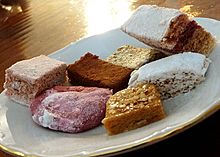Pastila facts for kids

Pastila from Kolomna
|
|
| Course | Confectionery |
|---|---|
| Place of origin | Russia |
| Main ingredients | fruit purée, egg whites, sugar or honey |
| Variations | Food coloring |
Pastila (Russian: пастила́) is a yummy, traditional Russian sweet treat! It's made from fruit, often apples, and has a light, airy texture. Imagine a soft, fruity puff that melts in your mouth – that's pastila! People in Russia have enjoyed this special candy for hundreds of years.
In the past, especially in Imperial Russia, these "small jellied sweetmeats" were served with tea. They often had a white, foamy top, a bit like marshmallow, but tasted purely of fruit.
A Sweet History
The first mentions of pastila in Russian writings go all the way back to the 16th century. The name "pastila" likely comes from Italian words like pastello or pastiglia. It might also come from the French word pastille, which means a small lozenge or tablet. These words all come from the Latin word pastillus, meaning a small loaf or pie.
How Pastila Was Made Long Ago
In the 1800s, pastila was usually made from tart Russian apples, like the Antonovka apple. Sometimes, people used mashed Northern berries, such as lingonberry, rowan, or currants. To make it sweet, they added honey or sugar. Egg whites were whipped in to make it light and airy.
The fruity mixture was then baked for many hours in a special Russian oven. After baking, it was carefully placed in layers inside a box made of alder wood. Then, it was left to dry even more in the same oven. This long process helped create its unique texture.
Pastila as a Special Treat
In Imperial Russia, pastila was considered a very expensive and fancy dessert. It cost about one and a half roubles, which was a lot of money back then. It was often made on large estates by workers called serfs. The cheapest pastila used honey instead of sugar. The special Russian stove provided a steady, gentle heat for two days to bake the fruit paste perfectly. There was even a Tatar version that was strained through a fine sieve, which helped keep apple seeds whole.
Pastila in Modern Times
During the Soviet period, pastila started to be made in factories using machines. While this made it easier to produce, many people felt it wasn't as good as the homemade kind. It became less popular than another similar sweet called zefir. Zefir is also made with whipped egg whites but uses special ingredients to make it thicker, like a gelling agent.
However, in the 2010s, traditional pastila started to become popular again! You can now find special versions from places like Kolomna and Belyov in stores.
Kolomna: The Home of Pastila
The city of Kolomna is famous for being the original home of "white-foam" pastila. Kolomna even has a museum and a museum factory dedicated to the history and traditions of making pastila. The museum is in an old merchant's house from the 1800s. The factory is in a historic building where pastila was once made. Other towns like Rzhev and Belyov were also known for making pastila.
Kolomna pastila has been made by hand from apples for over 300 years. The process involved whipping apple puree with egg whites and drying it in a stove. The finished pastila could be stored for many years! The first pastila factory in Kolomna opened in 1735. Sadly, after the Russian Revolution, the old pastila recipes and the sweet itself were almost forgotten.
Bringing Pastila Back to Life
In 2008, something exciting happened during a skating championship in Kolomna. A project called "History with Flavor" helped bring Kolomna pastila back to life! This led to the reopening of the pastila factory and the museum.
The museum is in a beautiful old building in the historic part of the city. Right next door, you can find the factory itself. When you visit, you can enjoy a fun show that tells the story of pastila. You also get to try different kinds of this unique sweet! There's another museum where visitors can learn about pastila's history and buy a box of this delicious dessert to take home.

